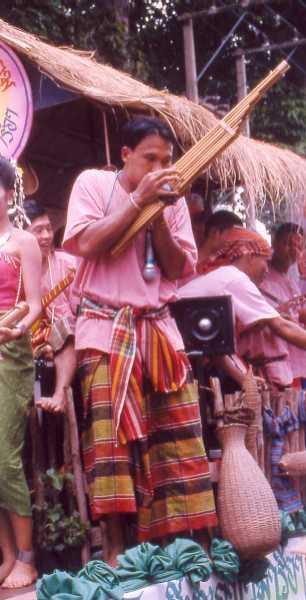Kaw law (Musical instrument)
Enlarge text Shrink text- Work cat.: Bussakorn Sumrongthong. Pōnglāng, 2010:p. 1 (Pōnglāng is a musical instrument played in northeastern Thailand, in particular Kalasin, Khon Kaen, Roi Et and Ubon Ratchathani Provinces. It is made of pieces of wood strung together, similar to the ranāt but without the resonator) p. 21 (Khō̜lō̜ is another name for Pōnglāng. This name comes from the term Kro̜lō̜, which is used to refer to a Pōnglāng ensemble in the Amphoe Muang Kalasin District of Kalasin Province.)
- Wikipedia, Apr. 17, 2015(pong lang; log xylophone from the Isan region of northeast Thailand; generally played by two players)
- Grove dictionary of musical instruments, 2nd edition, viewed online Apr. 17, 2015(Kaw law (pong lang): Xylophone with 12 diagonally suspended log bars, found principally in Kalasin Province, northeastern Thailand. Though resembling ancient bamboo instruments of similar design in the Vietnamese highlands, the kaw law attained its present form during the first half of the 20th century. It hangs from a tree or other support with the largest bar at the top and the smallest near the ground. Kaw law also denotes a xylophone of the Lao people in Thailand, consisting of 12 graduated bamboo tubes hanging between a tree and the player's leg.)
- New Grove dictionary of musical instruments, 1984:p. 366 (Kaw law (bong lang): Vertical xylophone with 12 logs, found principally in Kalasin Province, north-eastern Thailand. Though related to ancient instruments of the Vietnamese highlands, the kaw law attained its present form during the 20th century)
- p. 145 (bong-lang is from Galasin (Kalasin) province in the northeast region of Thailand; the bong-lang is a vertical xylophone, i.e., a succession of struck hardwood logs each with its own pitch) p. 147 ("According to informants, the proper name of the instrument is kaw-law." ( (Miller, T.E. The ranat and bong-lang: the question of origin of the Thai xylophones, via WWW, Apr. 21, 2015:) )
- Pong larng dance from Kalasin, Thailand, 1989?
The pong lang (Thai: โปงลาง, RTGS: ponglang, Thai pronunciation: [pōːŋ.lāːŋ]) is a xylophone from the Isan region of northeast Thailand. The instrument may be played as a standalone instrument, in pairs with one player playing melody and the other harmonizing, or as part of an orchestra. Players use carved two hardwood mallets. The instrument is not standardized and the number of tone bars and their size can vary. Unlike the ranat ek lek and ranat thum lek which are strung over a box, the pong lang is hung from a post or tree with the string of tone bars arcing down toward the ground. wide to short. The number of tone bars varies, and 12 or 15 tone bars may make up a set. The wider bars with lower pitch sit at the top of the string and the other end (with smaller high-pitched bars) may be hooked to the player's toe or to a belt around the player's waist. When there are two performers, they may sit on opposite sides of the post, facing one another. With two instruments, one plays the melody, the other plays a drone accompaniment or harmonics. The pong lang is mostly used for many occasions, especially for festivals and ceremonies. The instrument can be played solo or in an ensemble.
Read more on Wikipedia >
 Topic
Topic



